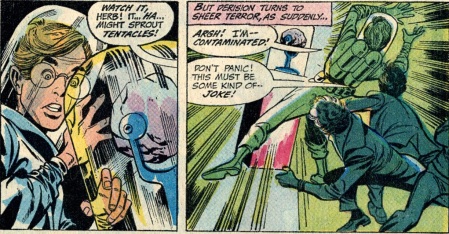
This is a bittersweet post, and that touch of melancholy is part of what has made me slow to put figurative pen to equally figurative paper for this set of books. On the one hand, we are starting a new month, full of the promise of adventure, but on the other, this month also holds the final issue of Aquaman’s solo series, the last solo Aquaman book that would be seen for six years until its brief revival, after which Aquaman would be absent from solo books until the beginning of the very divisive Pozner/Hamilton mini-series in the mid 80s, which, for whatever positive qualities it may have, is still guilty of starting the ‘let’s fix Aquaman’ approach to the character that endured for decades. It’s a crying shame, especially given the very high quality of this book and the incredible inventiveness of its creative team, SAG. Nonetheless, life, and comics, go on.
As I’ve mentioned before, the cancellation of this book was made all the more shocking and lamentable because it had much less to do with sales than with internal politics. It seems that then editor-in-chief Carmine Infantino didn’t much care for Dick Giordano’s style, so, when Giordano desired to leave editing and start inking full time, the head honcho took that as an opportunity to rid himself of the man. Now, Giordano was very fond of what he had created with Skeates and Aparo, so he offered to continue editing Aquaman freelance, but rather than agree to that or even replace him, Infantino just cancelled the book, despite the fact that it had maintained solid sales! The Aquaman Shrine has a great interview with Steve Skeates that reveals a bit of the behind the scenes drama.
However unjust the cancellation, it was presented as a fait accompli, and it was a shock to all involved and a major blow for the character. In fact, I would argue that it is this incident which crippled the character for years to come. It attached a stigma that his book couldn’t sell, despite the fact that sales had very little to do with the book’s fate. What’s worse, it robbed the hero of the chance for development and growth during a very important time in comics history, as I’ve mentioned before. While Batman, Superman, Green Lantern, Green Arrow, and many others were being revamped and redefined in extremely influential ways, Aquaman is left by the wayside, with only the SAG team’s incomplete efforts to support him. This is a situation that the character is only very recently starting to overcome, some forty years later.
Yet, not all is doom and gloom. As promised, I have a special treat for y’all today. You see, when the book was unceremoniously cancelled, Steve Skeates was left with a half-finished story. Yet, he was not one to be daunted by such a small matter as a cancellation, and he would eventually finish that story, but do so on the other side of the aisle. That’s right, in a 1974 issue of Marvel’s Submariner, Steve Skeates would pick up the dropped thread of this Aquaman adventure and finish the tale for Marvel’s own sea king. I’ll be covering that comic today, in addition to our usual fare. So, let’s see what this month has in store for us!
If you’re new to this little journey, you can check out the first post to learn what it’s all about.
Roll Call
(You can see everything published this month HERE)
- Action Comics #399
- Adventure Comics #405
- Aquaman #56 / (Sub-Mariner #72)
- Detective Comics #410
- The Flash #205 (Reprints, won’t be covered)
- Mr Miracle #1
- The Phantom Stranger #12
- Superboy #173
- Superman’s Girlfriend, Lois Lane #109
- Superman’s Pal, Jimmy Olsen #137
- Superman #236
- Teen Titans #32
Bolded entries are covered in this post, the others will be covered soon.
Aquaman #56

“The Creature That Devoured Detroit!”
Writer: Steve Skeates
Penciler: Jim Aparo
Inker: Dick Giordano
Letterer: Jim Aparo
Editor: Dick Giordano
“The Cave of Death!”
Writer: Steve Skeates
Penciler: Jim Aparo
Inker: Dick Giordano
Letterer: Jim Aparo
Here we have one of the all-time great Aquaman covers. It’s exciting, titanic in scope and promise, and other than the rather muddy colors, is pretty much a perfect composition. It’s got an old-school monster flick feel, right down to the title, like a 50s sci-fi film…but unfortunately it also bears little in common with the story inside. Just imagine what could have been, a massive struggle between the King of the Sea and a colossal monster from the watery depths! Instead, we get an offbeat, if unquestionably interesting, tale. I imagine I might have been a more than a tad disappointed if that cover had persuaded me to pick the book up off the newsstand, only to find no massive monstrosity within.

Man, Aparo could pack personality into a page!
Instead, the final issue of Aquaman begins in rather simple fashion. A husband and wife bicker over the minutia that can grow into its own sort of monster in a marriage, but the debate is postponed by the tuning in of a television to the “Warren Savin Show” (interestingly, that’s actually a pen-name that Skeates has used from time to time). The show promises to feature, of all people, the King of the Seven Seas as their special guest, but it is interrupted by a special report about a massive algae growth on Lake Erie threatening to consume the city of Detroit.

This bumper bloom seems to be caused by a mysterious satellite which is reflecting light onto the city and its surroundings at night, keeping the area in a perpetual daylight that has sparked this overgrowth. When the cameras cut back to the show, the Sea Sleuth is missing! The Aquatic Ace has rushed out of the studio to see what he can do about this threat, answering the call to action.

Too bad this is symbolic…
 Arriving in Detroit, Aquaman finds the green gunk everywhere and decides to look up an old friend of his, a former police scientist named Don Powers, to try to get a handle on the situation. Meanwhile, we cut to a strange figure in a garish costume, and we’re informed that this bargain-basement Batman is ‘The Crusader,’ a superhero who is ignoring the growing plight of the city to chase a car theft ring. We get a nice action sequence as the Crusader jumps the gang he’s been tracking and barely manages to subdue them.
Arriving in Detroit, Aquaman finds the green gunk everywhere and decides to look up an old friend of his, a former police scientist named Don Powers, to try to get a handle on the situation. Meanwhile, we cut to a strange figure in a garish costume, and we’re informed that this bargain-basement Batman is ‘The Crusader,’ a superhero who is ignoring the growing plight of the city to chase a car theft ring. We get a nice action sequence as the Crusader jumps the gang he’s been tracking and barely manages to subdue them.

After we see the orange and black clad figure finishes his fight, we switch over to follow Aquaman as he goes to consult his old friend, now a successful businessman and scientist, and the Sea King finds him at his corporate lab, where the fellow is completely unconcerned with the growing green tide swallowing the city, instead bragging about the reduction in crime thanks to the perpetual daylight and revealing that the mysterious satellite is, in fact, his.
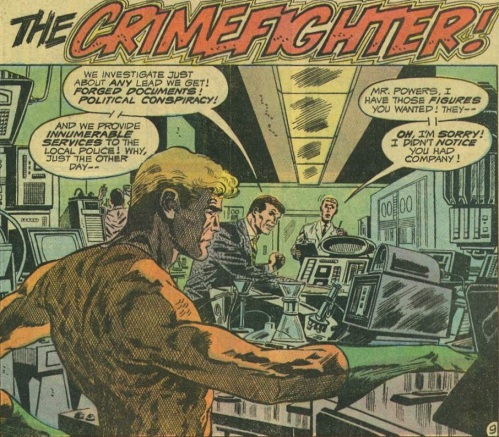
During their debate, Powers brings up the Crusader, and Arthur reveals that the League had refused him membership because he was considered unstable and too violent (He’d fit right in today, no doubt!), which is a fun little detail. When the Marine Marvel tries to take matters into his own hands, Powers and his flunkies jump him, and sadly, you guessed it, Aquaman earns another slot on the Head-Blow Headcount! Skeates really loved this device a bit too much.

Not again
With the real hero disabled, we watch as Powers slips into his private office and dons the costume of…the Crusader! In internal monologue, he reveals that he had an ulterior motive for launching the satellite. His low-light vision is fading, and he’s willing to let the whole city suffer just so he can continue playing costumed crimefighter. He justifies his selfishness by arguing that the case he’s working on is too big to abandon, and once he solves it he plans to destroy the satellite. Powers also thinks that this case will be his ticket into the big time, that it will help him prove himself. Now, just for some perspective, let’s remember that the case he’s trying to crack is no doomsday plot, no terrorist’s master plan, no city shaking scheme, just a car-theft ring. Priorities man, priorities!

While the Crusader continues his…well…crusade, Aquaman awakens on a park bench, having been dumped there by Powers’ goons, and before he can get back to the lab, he sees a young girl threatened by the growing green goo and rushes into the morass to save her. He does so without a second thought, putting her life ahead of his own, though the peril of the situation doesn’t entirely come through as well as I imagine Skeates intended.

A bit of a disappointing confrontation, really, and the dramatic title doesn’t help.
On his way back, he discovers a crowd surrounding a still figure on the pavement. The Crusader lies dead, not felled by an enemy’s bullet or having met his death in the line of duty. He just tripped over a wire and fell to his fate on the street below, his eyes finally having failed him. He is the very soul of anti-climax. When his mask is removed, the Sea King recognizes his friend and things begin to become clear to him. Rushing back to Powers’ building, the Marine Marvel smashes his way inside, taking no chances, and locks himself inside the control room until he can find the proper switch. The issue ends with the button pressed, the satellite destroyed, and the menace ended.

The title here, on the other hand, is pitch-perfect.
So, not exactly what one would expect from that cover, is it? This is a strange issue, but certainly an inventive and intriguing one. Skeates is doing what he has done all along, trying new things and experimenting with the medium. The story at the heart of this comic, the contrasting of two different concepts of heroism in the person of two very different heroes, is actually a great one. It’s still quite pertinent today. It’s the examination of the perennial conflict, between selflessness and selfishness. Aquaman’s selfless conduct throughout, abandoning the TV show to help Detroit, putting his life in danger to save the little girl, and even risking who knows what kinds of consequences to destroy the satellite, stands in relatively effective contrast to the purely selfish motives of the Crusader. That myopic manhunter, for his part, ignores all other concerns in search for his own fulfillment and fame, endangering the entire city, a city that he supposedly protects, in order to continue his callous crusade. The concept is a fascinating one, yet Skeates’ treatment thereof isn’t entirely successful.

Remember these images.
The story is far too rushed. We meet the Crusader and see his futile death in just a few pages. He’s not given the time to really develop the comparison appropriately, and compressing the setup and payoff into one book renders Aquaman’s contributions fairly slight. Part of the trouble is that the threat to the city doesn’t ever quite seem tremendous enough to justify everyone’s concern. We see the sludge surge up and endanger one little girl playing too close to the water, but that’s about it. Skeates commits one of the prime storytelling sins. He tells us about the threat rather than showing it convincingly. Now, part of the reason for that simply has to be lack of storytelling space. Nonetheless, this tale is certainly noteworthy for its innovation, and the central concept is worthwhile, despite its flaws. This was a remarkable plot for its time. Characters getting killed off was rare enough, but having a “hero” die, especially in the story in which he was introduced, was almost unheard of.
Of course, it almost goes without saying that the book is beautiful, with Aparo creating yet another cast of distinctive, interesting faces, lovely action, and rich settings. Perhaps the greatest calamity in the cancellation of the book is the fact that Aparo stops working on the character that he captured better than anyone else. Unfortunately, there is no shortage of four-color woe to be found in this comic’s cancellation, so that loss has plenty of competition. Nonetheless, this is a fun and entertaining read. It may be an offbeat ending to the series, but at least it’s an intriguing one. All things considered, I’ll give this final Aquaman story 3.5 Minutemen.

This issue also contains a super brief backup with Aquagirl, where she rescues a little boy foolishly playing too close to an ominously named threat called ‘The Cave of Death.’ Something of a theme this month, apparently. It’s only two pages, so really too brief to rate as a story by itself, but it’s always nice to see Aquagirl in action. It seems clear that Skeates was setting something else up, and this is just one more way in which the sudden cancellation of the book is a shame.

The Savage Sub-Mariner #72
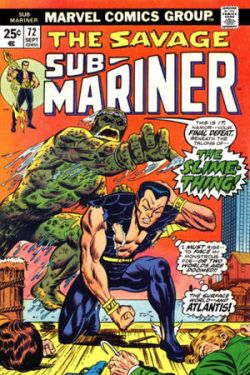
“From the Void It Came…”
Writer: Steve Skeates
Penciler: Dan Adkins
Inker: Vince Colletta
Colourist: Linda Lessmann
Letterer: Artie Simek
Editor: Roy Thomas
You can see what else Marvel put out this month HERE.
For our special feature, we once again pass across the aisle to Marvel comics, but this time it isn’t ersatz counterparts we see but an actual story-line continued. It’s a shame that the rest of the SAG team wasn’t able to join Skeates for this revival of his Aquaman work, but he’s creating with a new team. The results are surprisingly fitting for a Marvel comic considering the origins of this yarn over at DC.
While DC’s Sea King is my favorite comic character, I’ve also always had a soft spot for Marvel’s ocean monarch, Namor, the Sub-Mariner. He’s not one of my favorite Marvel characters, but I’ve always liked him, and when I read through the classic Fantastic Four stories where Stan Lee and Jack Kirby brought him back, I really started to appreciate comics first anti-hero. Incidentally, Kirby’s work on the history of Namor’s Atlantis is one of the coolest things ever. While Namor’s temper can wear thin after a while, I’ve always appreciated the unfailing regalness of his character. He’s one of the few times where comics have captured the ideal of royalty. I’m just now starting to read his Silver Age solo series, and I’m only up to the 40s at the time of this posting, but I’m quite enjoying those adventures. For this outing, I’m skipping ahead a few years, so I’m reading this tale without much context.
It begins with the Sub-Mariner himself swimming through the terribly polluted waters offshore of a major city and commenting, in usual fashion, on how terrible us surface dwellers are. Notably, at this point Marvel’s Sea King is wearing his more substantial costume that replaced his green trunks. It’s certainly a more dignified look, and it’s grown on me, though, being something of a purist, I tend to be biased in favor of original looks. Sartorial concerns aside, the Sub-Mariner takes to the sky, still meditating on the evils of the surface world.

Our narrative lens shifts, and we move into space two years previously where a strange green blob, some bizarre alien lifeform, drifts through the cosmos and lands upon a certain satellite, just before a (blue) gloved hand destroys its temporary lodging. Take a look at that image. Does it look familiar? That’s right, Skeates intentionally evokes the last panels from Aquaman #56 in order to tie these two stories together in a subtle crossover.

The creature rides the wreckage down and splashes into the ocean nearby where Namor will come ashore. The being observes the sealife that passes by and decides to emulate those ocean dwellers by creating a body out of the slime on the seabed and the wreckage from the satellite. The process takes the intervening years, and we get a really nice series of panels as the alien heads to the surface to explore.

Meanwhile, the Sub-Mariner has encountered trouble in the form of a strange pair of humans. There’s something just a bit odd about these guys, and you might not be able to put your finger on it. I wasn’t, at first. Don’t worry, we’ll come back to that. These two toughs decide, with suicidal bravado, to pick a fight with Namor because he’s different. It’s a case of prejudice, and bizarrely, the attack is accompanied by a quote from Hitler which talks about the effectiveness of visuals in delivering messages. Oookay.

This looks like a cover for a Double Dragon game.
The Prince of the Blood, who, let’s’ remember, has traded punches with the Hulk, belts his normal human antagonist and somehow doesn’t turn his head into a fine red mist, instead sending him flying into the drink. The thug’s friend jumps Namor in reprisal, voicing a rather strange response to the attack, “You’ve probably ruined him for life!” How odd. As the two tussle, the curious alien being reaches the dock, and they smash into him, leading all three to tumble into the water. Interestingly, the narration notes that Namor has become somewhat unstable because of his constant battles, so that he meets the strange, monstrous newcomer with open hostility, just assuming that it’s a foe, and thereby leaving his original human antagonist to his watery fate.

While the fellow’s companion drags him to the surface, the Sub-Mariner and the star-spawned creature trade blows. Namor pours all of his rage, all of his frustration, into this fight, attacking blindly, but the creature literally blinds the Atlantean in response. Even that doesn’t stop the Sub-Mariner, who grapples with his slimy foe.

Finally, having had enough of this whole ‘body’ business, the being launches itself skyward once more, though, having meant no harm, as it passes into space it uses its powers to restore life to the drowned man and even, surprisingly enough, restore Namor’s sight. Skeates plays with superhero conventions here to some pretty good effect, raising some questions about the violent ways such characters tend to respond to the unknown.

For his part, before his eyes are healed, the Prince of the Blood realizes that his metaphorical blindness may have trapped him in literal blindness. His anger and rage kept him from trying to communicate with the creature and may have doomed him to perpetual blackness. It’s an interesting and relatively effective message about understanding and tolerance of the “Other.” And with that, Namor heads for sepulchral Atlantis (previously destroyed, it seems) while the two humans head home as well, with one of them saying, seemingly apropos of nothing, that he just got a new professional wrestling magazine. With these scenes, our story ends.

So, what was the discordant note that the two wharf rats kept striking? Well, these two toughs, Skeates later confirmed, were meant to be a gay couple. Hence the rather flamboyant dress of the first thug, who was, by the way, named Bruce, a moniker with some associations with the gay community at the time, as I understand. Now, you may wonder what in the world their sexuality has to do with anything in this oddball story, but it really does add a little depth to Skeates’ treatment of the theme of intolerance and metaphoric blindness. You’ve got these two characters acting as bigots who have themselves suffered from intolerance, abuse, and bigotry, which is ironic. While it could just be seen as anti-gay, it could also be read as an indication of the depth to which distrust of the “Other” is built into human nature, how deeply the disease goes. Even those of us with reason to sympathize with societal outcasts can find it easier to lash out than attempt to act with understanding.

Nonetheless, that was certainly an unusual wrinkle for comics in 1974, when you could not present any openly gay characters. Once again, Skeates is experimenting with the genre. The story itself is solid enough. It’s more effective in its delivery of its message than in telling a particularly compelling and enjoyable adventure yarn, though. Yet, I do enjoy the focus on Namor’s reaction to the mysterious creature. It makes rather perfect sense given the Sub-Mariner’s characterization over the course of his series and the endless series of conflicts and reverses he’s faced. There’s a very human element in his blind rage. Still, the story feels a bit disjointed, with the conflict with the two morons on the dock coming out of absolutely nowhere. I know people are plenty stupid, but who says to themselves, ‘I think I want to pick a fight with that guy that can punch through steel!’ In the end, I suppose I’ll give this story a 3.5 as well. It’s an interesting one, if not stellar.

P.S.: Oddly, this story, picking up from the final issue of Aquaman, falls on the final issue of the Sub-Mariner, who has outlived his distinguished counterpart by three years at this point but falls prey to a similar fate, and, ironically, with the same hand at the helm! Steve Skeates had to wonder if he was jinxed when it came to aquatic characters!
The Head-Blow Headcount:


















Poor Aquaman adds yet another appearance on the Wall of Shame. This really illustrates just how much Skeates relied on the head-blow plot device. Whenever he needed to remove the Sea King from the story for a few pages, it seems a sock on the noggin was the first club out of the bag. The results are self-evident, with Aquaman more than tripling the next most common resident on the wall in total head-blows. At least one benefit from the lamentable cancellation of his book is he won’t be adding many more entries in this feature any time soon!
Final Thoughts:
These two comics make for an intriguing pair, a unique case (at the time) with a story translating across both companies and years (Of course, the Marvel character Mantis will see a similar transition later in the decade). Even more unusually, the stories are very reflective of their universes, DC and Marvel, with each comic fitting surprisingly well into the style of their respective companies. The DC story is full of bigger ideas, while the Marvel tale is much more melodramatic and emotionally focused. The contrast illustrates Skeates’ skill as a writer, as one of the great tests of an author’s mettle is the ability to write well in different styles.
I’m really curious what shape the second story would have taken if it had graced the pages of Aquaman as intended. One wonders if the muck creature from the cover of #56 might actually have put in an appearance after all, perhaps on a much grander scale than Namor’s unwitting sparring partner. If we assume that the alien creature and its curious attempt to explore our little globe was always the core of the concept, then perhaps it would make sense for all of that algae coating Detroit to be incorporated into the being’s new body. We might have gotten a version of that massive monstrosity after all. Sadly, we’ll never know what might have been.
That is, truly, the greatest misfortune to be found in the sudden and unlooked-for cancellation of the Aquaman book, the loss of what might have been. The SAG team had been paving the way for a whole era of stories, layering in hooks for coming arcs and continuing plot threads, setting up some really intriguing story possibilities, and creating a fascinating setting for the Sea King. There are too many lost opportunities and abandoned elements in this run to count, like the rabble-rousing politician and his bid for power, the rocky relationship between Tula and Garth, the myriad underwater civilizations we’ve encountered in the preceding pages of the book, the microscopic world in Mera’s ring, Ocean Master’s recovered memories, and so much more that could have been. I’ll always wonder what plans the SAG team had, what heights the book might have reached in the years to come. How might the undersea setting have grown? How might the Aqua-Family have evolved? The possibilities really dazzle the imagination, don’t they? Instead, we get this rather off=beat finale. The book ends, not with a whimper, but neither does it close with a roar worthy of what has come before. Instead, it slips away without fanfare or acknowledgement, without the slightest hint that this is the final issue.
It’s one of the great comic calamities, and so it is with a heavy heart, that I bid adieu to one of the best Aquaman runs and one of my favorite creative teams. And it is also time that I say goodbye to this post. I hope you’ll join me again soon as I resume our regularly scheduled Bronze Age browsing. Until then, keep the Heroic Ideal alive!
 “Return of the Alien!”
“Return of the Alien!”





 She explains that her captors have opened her mind and taught her to think for herself, strangely enough. Yet, even more surprising, when he tells the young lady that he’s there to rescue her, she refuses, saying she’s happy in her role! While she may be a captive, she is, in many ways, more free than she was in her oppressive home. It’s an interesting wrinkle and an unexpected twist. Yet, it is also a bit unsatisfying. Our hero has gone through all of this to save her, and she doesn’t want to be saved!
She explains that her captors have opened her mind and taught her to think for herself, strangely enough. Yet, even more surprising, when he tells the young lady that he’s there to rescue her, she refuses, saying she’s happy in her role! While she may be a captive, she is, in many ways, more free than she was in her oppressive home. It’s an interesting wrinkle and an unexpected twist. Yet, it is also a bit unsatisfying. Our hero has gone through all of this to save her, and she doesn’t want to be saved!


























 “Crime Wave!”
“Crime Wave!”





 We watch as the rampaging monster attacks Atlantis, and when Aquaman responds, he can’t seem to make any headway against the beast. He gets weaker as it gets stronger! Despite his best efforts, Thanatos knocks him out, causing him to awaken in bed once again. Mera tells her husband that Thanatos headed out to sea, and despite being weakened, the Marine Marvel heads out after him, fearing what will happen to life in the ocean if the monster has free reign.
We watch as the rampaging monster attacks Atlantis, and when Aquaman responds, he can’t seem to make any headway against the beast. He gets weaker as it gets stronger! Despite his best efforts, Thanatos knocks him out, causing him to awaken in bed once again. Mera tells her husband that Thanatos headed out to sea, and despite being weakened, the Marine Marvel heads out after him, fearing what will happen to life in the ocean if the monster has free reign. Well, we can probably figure out what’s happening to Aquaman now, which is why I think this reveal should probably have been postponed a bit. We get another mysterious black panel, now a bit more understandable, and suddenly the King of the Sea arrives in…an underwater Wild West town! It’s quite strange, but given that we know he’s in a dreamworld now, it sort of works. I really wish that Skeates had toyed with this a bit more, told us, perhaps, why Aquaman would imagine a western town for his showdown. I feel like there’s some fun character work that could have been done there. Was a young Arthur Curry a fan of
Well, we can probably figure out what’s happening to Aquaman now, which is why I think this reveal should probably have been postponed a bit. We get another mysterious black panel, now a bit more understandable, and suddenly the King of the Sea arrives in…an underwater Wild West town! It’s quite strange, but given that we know he’s in a dreamworld now, it sort of works. I really wish that Skeates had toyed with this a bit more, told us, perhaps, why Aquaman would imagine a western town for his showdown. I feel like there’s some fun character work that could have been done there. Was a young Arthur Curry a fan of 


 As I said, this is a weird issue. The attempt to tell a dream story within another story is an interesting one, but Skeates breaks his own story logic by following Thanatos for a time, despite the fact that, in the scheme he sets up, this monster should be nothing more than a manifestation of Aquaman’s death-drive. He shouldn’t really have his own motivations and desires, short of killing his alter-ego, especially because this is all happening in Arthur’s mind. I think it would have been more effective to just have the beast show up every few pages and disappear inexplicably. Skeates almost achieves that, with the constant reversions to the palace and the clever use of his black panels. I do like that the villains have a hard time keeping Aquaman under control. It’s another of those story beats that emphasize the power of his mind and spirit, which I always enjoy.
As I said, this is a weird issue. The attempt to tell a dream story within another story is an interesting one, but Skeates breaks his own story logic by following Thanatos for a time, despite the fact that, in the scheme he sets up, this monster should be nothing more than a manifestation of Aquaman’s death-drive. He shouldn’t really have his own motivations and desires, short of killing his alter-ego, especially because this is all happening in Arthur’s mind. I think it would have been more effective to just have the beast show up every few pages and disappear inexplicably. Skeates almost achieves that, with the constant reversions to the palace and the clever use of his black panels. I do like that the villains have a hard time keeping Aquaman under control. It’s another of those story beats that emphasize the power of his mind and spirit, which I always enjoy.

 “The Demon of Gothos Mansion!”
“The Demon of Gothos Mansion!” The story centers around Alfred’s niece, Daphne Pennyworth, who made an appearance not that long ago in
The story centers around Alfred’s niece, Daphne Pennyworth, who made an appearance not that long ago in 

 Now with some idea of what the trouble is, the Masked Manhunter goes in search of Daphne, who he finds locked in a tower of the mansion. She fills him in on her predicament, telling him she was hired to teach Heathrow’s two children, but she discovered that they were “a pair of hideous dwarves!” Whoa, I’m thinking that’s not politically correct! Apparently Heathrow forced her to don an elaborate old-fashioned dress, the same dress as worn by the woman in an old portrait in her room, a woman who could have been her twin. The mystery nicely established, Batman breaks her out, only to fall prey to a trap and be taken prisoner by Heathrow’s two little henchmen.
Now with some idea of what the trouble is, the Masked Manhunter goes in search of Daphne, who he finds locked in a tower of the mansion. She fills him in on her predicament, telling him she was hired to teach Heathrow’s two children, but she discovered that they were “a pair of hideous dwarves!” Whoa, I’m thinking that’s not politically correct! Apparently Heathrow forced her to don an elaborate old-fashioned dress, the same dress as worn by the woman in an old portrait in her room, a woman who could have been her twin. The mystery nicely established, Batman breaks her out, only to fall prey to a trap and be taken prisoner by Heathrow’s two little henchmen.



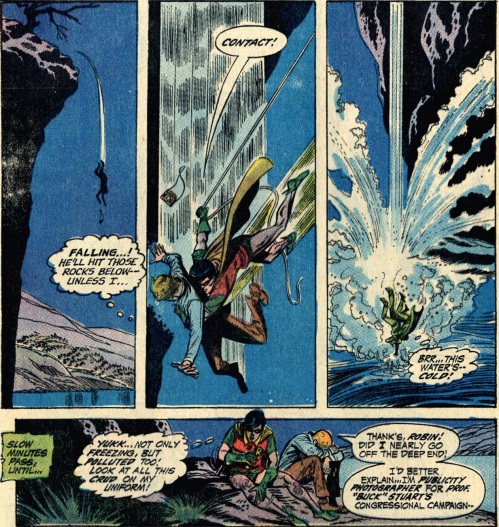



 “The Maid of Doom!”
“The Maid of Doom!”





 “Is California Sinking?”
“Is California Sinking?”

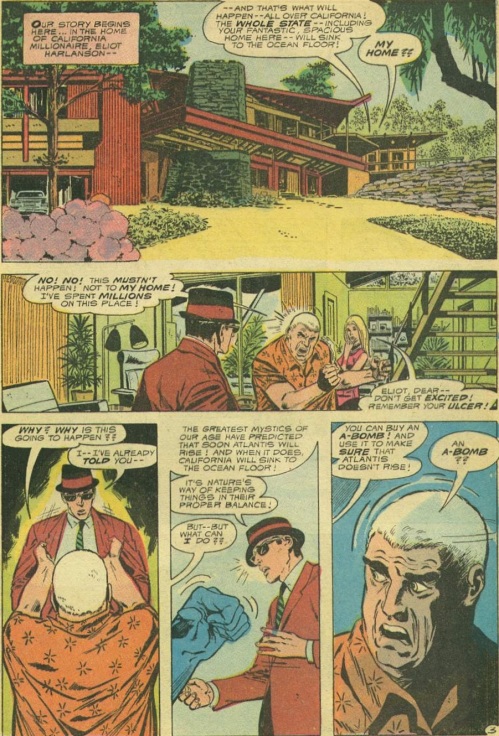


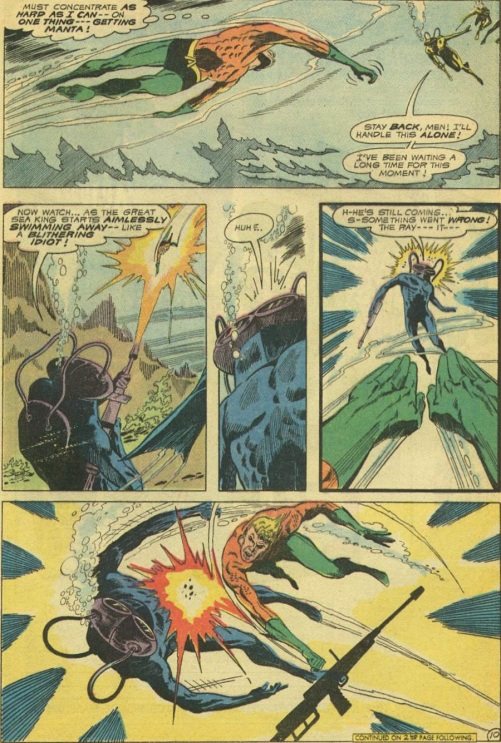






 “The Punishment of Superman’s Son”
“The Punishment of Superman’s Son”
















 “The Traders’ Trap”
“The Traders’ Trap”





 Well, to turn back to our tale, the Sea King attempts to fight his way into the colony, but he is felled by a…*gasp* head blow! Yep, poor Arthur gets a second spot on the Head-Blow Headcount wall. I’m afraid it won’t be his last, either. I will say this for the noggin knock, though, at least these alien inhabitants of this land might actually have the strength to knock our hero out with one shot, unlike the average humans who tend to do so. Either way, his captors decide to carry him to the “Extermination Chamber”! Dun dun, DUNNN!
Well, to turn back to our tale, the Sea King attempts to fight his way into the colony, but he is felled by a…*gasp* head blow! Yep, poor Arthur gets a second spot on the Head-Blow Headcount wall. I’m afraid it won’t be his last, either. I will say this for the noggin knock, though, at least these alien inhabitants of this land might actually have the strength to knock our hero out with one shot, unlike the average humans who tend to do so. Either way, his captors decide to carry him to the “Extermination Chamber”! Dun dun, DUNNN!





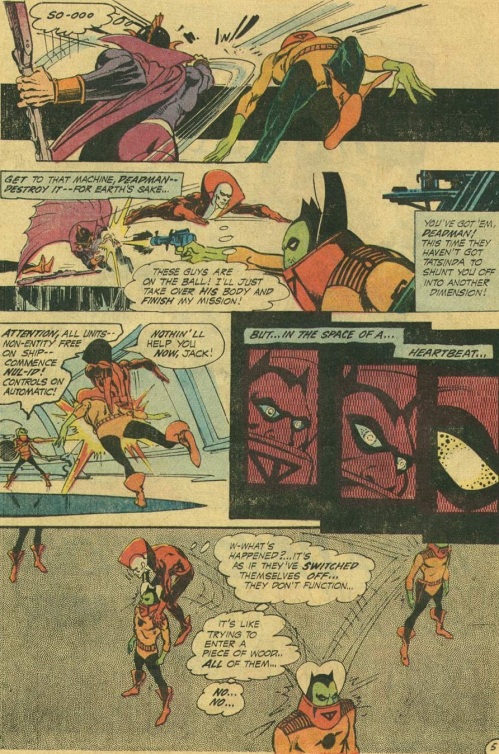




 Cover Artist: Curt Swan
Cover Artist: Curt Swan






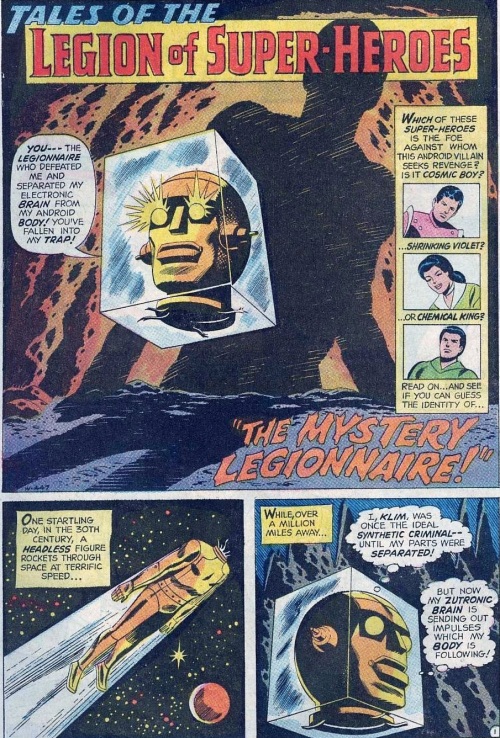






 Cover Artist: Nick Cardy
Cover Artist: Nick Cardy


















 Cover Artist: Neal Adams
Cover Artist: Neal Adams











 Cover Artist: Curt Swan
Cover Artist: Curt Swan














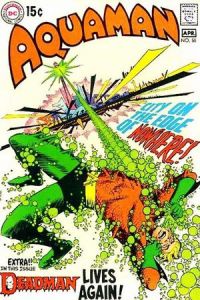 Cover Artist: Nick Cardy
Cover Artist: Nick Cardy










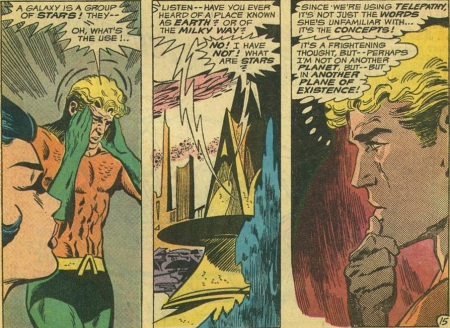


 Kushna informs Brand that he can begin his quest, but first he must address a danger that threatens the entire world, and she points him towards the aquatic villain without much more explanation. Deadman pops in on Orm and plays fly on the wall long enough to observe him plant some sort of device and meet with a bizarre pair of aliens near a otherworldly craft. I’m not crazy about the design of these aliens, as they are a bit too Silve Age-y for my tastes, but I’ll be darned if they don’t look quite striking in Adam’s stark pencils.
Kushna informs Brand that he can begin his quest, but first he must address a danger that threatens the entire world, and she points him towards the aquatic villain without much more explanation. Deadman pops in on Orm and plays fly on the wall long enough to observe him plant some sort of device and meet with a bizarre pair of aliens near a otherworldly craft. I’m not crazy about the design of these aliens, as they are a bit too Silve Age-y for my tastes, but I’ll be darned if they don’t look quite striking in Adam’s stark pencils.

 Executive Editor: Carmine Infantino
Executive Editor: Carmine Infantino







